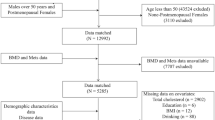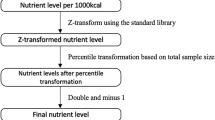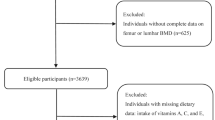Abstract
It seemed to be common sense that malnutrition was associated with osteoporosis, but there were few studies with detailed data proving that. Additionally, the association between BMI and osteoporosis was still under discussion. In our study of 138 patients, we first confirmed the association between nutrition and osteoporosis with propensity score matching method reducing the confounding bias, then discovered that body mass index (BMI) and 25OHD level acted as two crucial factors of nutrition risk-mediated osteoporosis. Moreover, a new BMI classification was proposed in our article to do more help for nutrition management and anti-osteoporosis treatment for the old in China. Consequently, nutrition is important to bone health, with BMI and 25OHD level playing key roles.
This is a preview of subscription content, access via your institution
Access options
Subscribe to this journal
Receive 12 print issues and online access
$259.00 per year
only $21.58 per issue
Buy this article
- Purchase on SpringerLink
- Instant access to full article PDF
Prices may be subject to local taxes which are calculated during checkout
Similar content being viewed by others
References
Bechard LJ, Duggan C, Tougerdecker R, Parrott JS, Rothpletzpuglia P, Byhamgray L, et al. Nutritional status-based on body mass index is associated with morbidity and mortality in mechanically ventilated critically ill children in the PICU. Crit Care Med. 2016;44:1530.
Benoit M, Grass F, Demartines N, Coti-Bertrand P, Schäfer M, Hübner M. Use of the nutritional risk score by surgeons and nutritionists. Clin Nutr. 2015;35:230–3.
Caccialanza R, Klersy C, Cereda E, Cameletti B, Bonoldi A, Bonardi C, et al. Nutritional parameters associated with prolonged hospital stay among ambulatory adult patients. Can Med Assoc J. 2010;182:1843–9.
Lee J, Little TD. A practical guide to propensity score analysis for applied clinical research. Behav Res Ther. 2017;98:76–90.
Ranstam J, Cook JA. Statistical models: an overview. Br J Surg. 2016;103:1047.
Kondrup J, Rasmussen HH, Hamberg O, Stanga Z. Nutritional risk screening (NRS 2002): a new method based on an analysis of controlled clinical trials. Clin Nutr. 2003;22:321.
Khalatbari-Soltani S, Marques-Vidal P. Impact of nutritional risk screening in hospitalized patients on management, outcome and costs: A retrospective study. Clin Nutr. 2016;35:1340–6.
Budzyński J, Tojek K, Czerniak B, Banaszkiewicz Z. Scores of nutritional risk and parameters of nutritional status assessment as predictors of in-hospital mortality and readmissions in the general hospital population. Clin Nutr. 2016;35:1464–71.
Felder S, Lechtenboehmer C, Bally M, Fehr R, Deiss M, Faessler L, et al. Association of nutritional risk and adverse medical outcomes across different medical inpatient populations. Nutrition. 2015;31:1385.
Tastan Y, Kann PH, Tinneberg HR, Hadji P, Müller-Ladner U, Lange U, et al. Low bone mineral density and vitamin d deficiency correlated with genetics and other bone markers in female Turkish immigrants in Germany. Clin Rheumatol. 2016;35:1–7.
Author contributions
Li was in charge of the clinical data collection and analysis, and Hui was in charge of PSM analysis and logistic regression analysis in our study; Zhang was in charge of the surgical treatment of osteoporotic fractures, and Yu was in charge of clinical nutritional treatment. Xiao Chang helped in data collection and analysis; ML and YW gave many necessary suggestions in the aspect of osteoporosis, 25OHD and Ca treatment.
Author information
Authors and Affiliations
Corresponding authors
Ethics declarations
Conflict of interest
The authors declare that they have no conflict of interest.
Electronic supplementary material
Rights and permissions
About this article
Cite this article
Li, Y., Hui, M., Chang, X. et al. BMI reduction and vitamin D insufficiency mediated osteoporosis and fragility fractures in patients at nutritional risk: a cross-sectional study. Eur J Clin Nutr 72, 455–459 (2018). https://doi.org/10.1038/s41430-017-0067-9
Received:
Revised:
Accepted:
Published:
Issue Date:
DOI: https://doi.org/10.1038/s41430-017-0067-9
This article is cited by
-
The association between dietary zinc intake and osteopenia, osteoporosis in patients with rheumatoid arthritis
BMC Musculoskeletal Disorders (2024)
-
Blood lipid levels in patients with osteopenia and osteoporosis:a systematic review and meta-analysis
Journal of Bone and Mineral Metabolism (2021)



